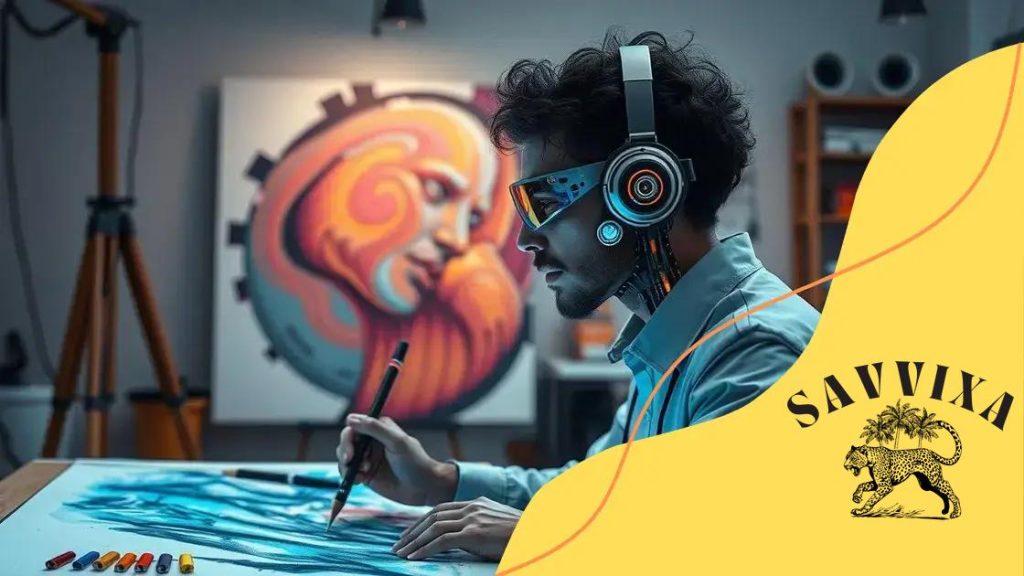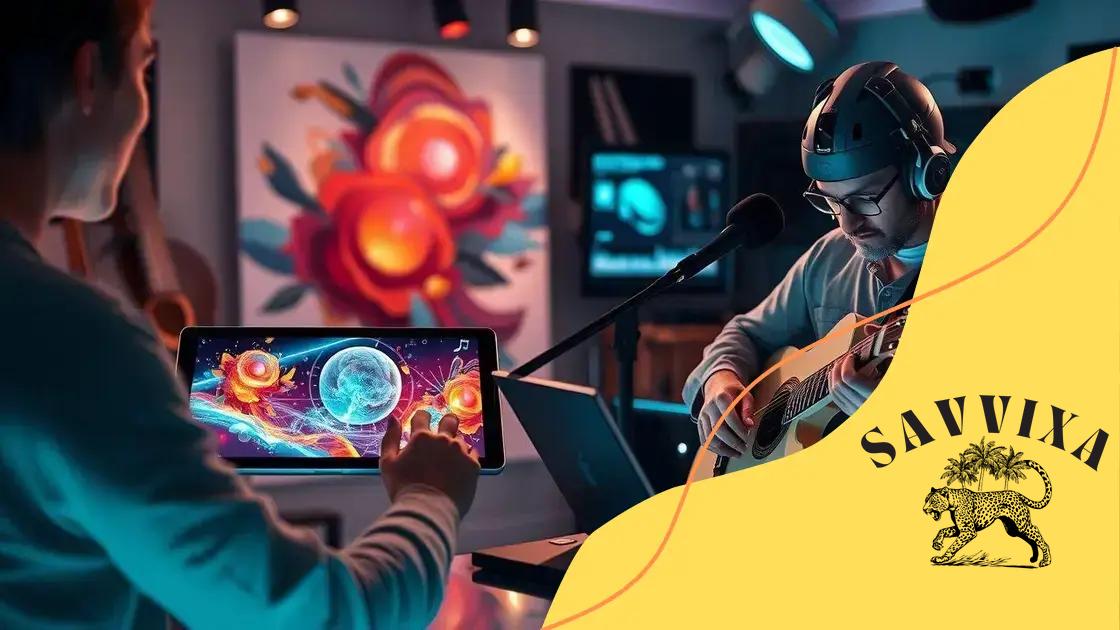The role of AI in transforming the creative industries

The role of AI in transforming the creative industries includes enhancing artistic expression, promoting personalized content, and enabling collaboration between humans and machines, while addressing ethical concerns and focusing on sustainability.
The role of AI in transforming the creative industries is more significant than ever. Have you noticed how technology is reshaping art, music, and design? Let’s dive into this fascinating intersection of creativity and innovation.
Emerging AI technologies in creative sectors
Emerging AI technologies are transforming the creative sectors in exciting ways. From art to music, these innovations are reshaping how we think about creativity. Let’s explore some of the most influential technologies and their impact on creative industries.
AI in Visual Arts
AI tools are becoming essential for artists. Programs can now analyze styles and create pieces that mimic famous artists. These technologies assist artists in pushing boundaries and experimenting with creativity.
- Generative Adversarial Networks (GANs) produce unique artworks.
- AI tools can suggest color palettes and styles.
- Accessibility for non-artists to create art easily.
As these tools improve, the collaboration between AI and human creativity intensifies. Artists can spend less time on repetitive tasks and more time on conceptual development.
AI in Music Creation
In the realm of music, AI algorithms can compose scores and provide inspiration. These technologies analyze vast databases of music to generate original melodies. Musicians now have new collaborators—AI systems that can enhance their compositions.
- AI helps in identifying popular trends in music.
- Utilization of machine learning for personalized music suggestions.
- Automated mixing and mastering tools streamline production.
The potential for creating new genres is enormous. Musicians who embrace these tools find their creative horizons expanding in unexpected ways. With AI, the possibilities are endless, opening up new avenues for both budding and seasoned artists.
As we continue to witness the growth of AI technologies in creative sectors, the intersection between human creativity and artificial intelligence becomes more dynamic. This evolution is not just a trend but a significant shift that will redefine creativity in the years to come.
Case studies of AI in arts and media
Case studies of AI in arts and media showcase how technology is reshaping traditional creative processes. By analyzing real-world applications, we uncover the power of AI in enhancing creativity and efficiency.
AI in Film Production
One notable application is in film production. AI algorithms are now used for script analysis, predicting audience preferences and even selecting casting decisions. This allows filmmakers to tailor their projects more closely to audience expectations.
- Automated editing tools streamline the post-production process.
- AI-assisted visual effects enhance realism in movies.
- Predictive analytics can forecast box office success.
This integration of AI helps filmmakers focus on storytelling while optimizing production efforts.
AI in Music Industry
Another fascinating case is in music composition. Companies like Amper Music and Jukedeck use AI to create original music tracks based on user inputs. This innovation empowers creators by providing them with unique scores quickly.
- Customizable music generation based on mood and genre.
- AI tools help musicians brainstorm new ideas.
- Accessibility for anyone, regardless of musical training.
As artists collaborate with AI, they unlock fresh avenues of creativity. The relationship between AI and human artistry is evolving, leading to innovative musical expressions.
AI in Visual Arts
In visual arts, numerous projects demonstrate AI’s capabilities. Artists are using AI tools like DeepArt and Runway ML to explore new styles and techniques. These platforms enable artists to generate breathtaking visuals with minimal effort.
- AI can translate photos into various artistic styles.
- Collaboration between artists and AI creates innovative artworks.
- Accessibility for everyday users to create art easily.
These case studies not only highlight the role of AI in arts and media but also invite us to consider future possibilities. As these tools evolve, their potential to inspire new forms of expression continues to grow.
How AI is enhancing creativity

AI is enhancing creativity in significant ways, allowing artists to explore new realms of expression. With advanced algorithms and machine learning, artists are tapping into tools that elevate their creative processes.
Generative Art
One way AI enhances creativity is through generative art. Algorithms can create unique visual pieces based on various inputs and parameters set by artists. This process encourages experimentation and provides artists with unexpected results.
- Artists can input themes and styles for AI to generate visuals.
- These tools help in brainstorming ideas and inspire new directions.
- Collaboration with AI often leads to innovations in techniques.
The fusion of technology and creativity enables artists to break traditional boundaries. By using AI, creators discover fresh approaches to their work.
AI in Music Creation
AI is also transforming the music industry. Programs like OpenAI’s MuseNet offer musicians the opportunity to compose original music effortlessly. These tools analyze existing music and generate new compositions that blend styles and genres.
- AI can suggest melodies and structures to enhance creativity.
- Musicians collaborate with AI to explore diverse musical landscapes.
- Automated music generation allows for quick experimentation.
As artists use AI to create music, they often find their creativity revived. This integration of AI tools allows for greater exploration of sound and emotion.
Furthermore, AI’s ability to analyze audience preferences can shape how art and music are created. By understanding trends and tastes, artists can tailor their work to resonate more deeply with their audience. This insight fosters a closer connection between creators and consumers, making the creative process even more engaging. As AI continues to enhance creativity, the possibilities for artistic expression are truly limitless.
Ethical considerations of AI in creativity
Ethical considerations of AI in creativity are essential as these technologies become more integrated into artistic practices. The collaboration between AI and human creators raises important questions about authorship, originality, and the use of AI-generated content.
Ownership and Copyright Issues
One significant concern is ownership. When AI creates a piece of art or music, who holds the copyright? This issue becomes more complex as AI processes vast amounts of existing works, blending styles and influences.
- Is the human artist the creator or just a facilitator?
- AI-generated works challenge traditional copyright laws.
- Clarifying ownership is crucial for artists’ rights.
As we navigate these challenges, defining the role of AI as either a tool or a co-creator is vital.
Bias in AI Algorithms
Another critical area of concern is bias in AI algorithms. If AI systems are trained on biased data, they may perpetuate stereotypes or exclude diverse perspectives in their outputs. Ensuring that AI reflects the rich tapestry of human experience is essential.
- Bias can lead to misrepresentation in arts and media.
- Diverse datasets are needed to create fair representations.
- Artists should be aware of the limitations of AI tools.
Addressing these issues requires collaboration between technologists and artists to create responsible AI systems.
Furthermore, the automation of art creation raises questions about the value of human creativity. As AI becomes more capable, there are concerns about the risk of devaluing human work and creativity. Finding a balance between leveraging AI’s capabilities and preserving the unique aspects of human expression is crucial for the future of creative industries. Engaging in conversations about ethics will help shape how AI can be a positive force in the arts while respecting the foundational principles of creativity.
Future trends of AI in creative industries
Future trends of AI in creative industries are shaping the way we approach art, media, and entertainment. As technology advances, artists and creators are finding innovative ways to harness the power of AI.
Personalization in Content Creation
One trend is the rise of personalization in content creation. AI algorithms can analyze user data to create tailored experiences. This means that music, films, and artwork can adapt to individual preferences.
- Custom playlists based on listening habits.
- Interactive films that change paths based on viewer choices.
- Artworks that evolve with viewer interactions.
This level of personalization encourages deeper connections between creators and audiences, making art more engaging.
Collaboration Between Humans and AI
Another exciting trend is the collaboration between humans and AI. Artists are increasingly partnering with AI tools to amplify their creativity. This partnership can lead to new art forms and unique compositions.
- Using AI to generate initial concepts that artists refine.
- AI systems suggesting new techniques and styles.
- Musicians experimenting with AI-generated beats and melodies.
The synergy of human intuition and AI capabilities opens up endless possibilities for innovation in creative practices.
Sustainability in Creative Processes
Future trends also focus on sustainability in creative industries. AI can optimize production processes to reduce waste and energy consumption. For instance, AI-driven tools can ensure efficient resource use in film production and art creation.
- Automating repetitive tasks to save time and resources.
- Using AI to analyze and predict material needs, minimizing excess.
- Promoting eco-friendly methods through AI-guided practices.
As sustainability becomes a priority, AI will play a crucial role in making the creative process more responsible and efficient. By embracing these future trends, the creative industries can evolve in ways that honor both artistry and ethical practices.
FAQ – Frequently Asked Questions about AI in Creative Industries
How is AI affecting creativity in the arts?
AI enhances creativity by providing new tools and insights, allowing artists to explore novel concepts and streamline their processes.
What are the ethical concerns regarding AI in creativity?
Key ethical concerns include ownership of AI-generated content and the potential for bias in AI algorithms.
How is personalization being utilized in creative content?
AI analyzes user data to create personalized experiences in music, film, and art, catering to individual tastes.
What future trends are expected for AI in creative industries?
Future trends include closer collaboration between AI and artists, increased personalization, and a focus on sustainability in production practices.